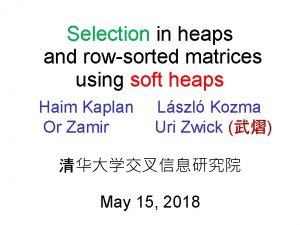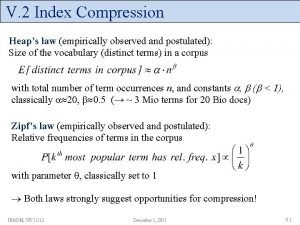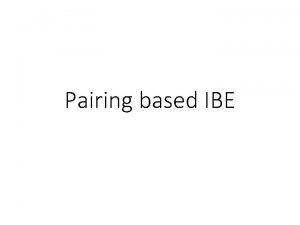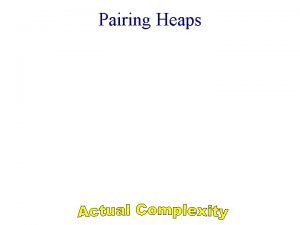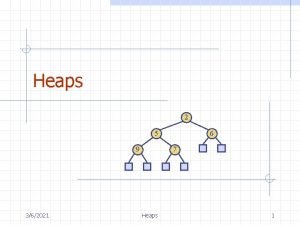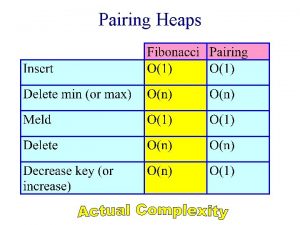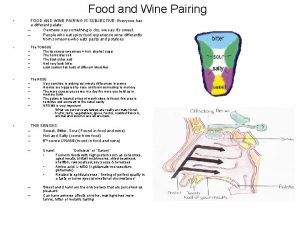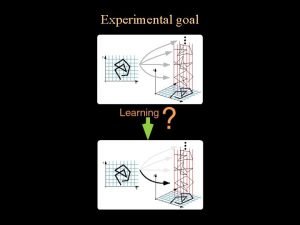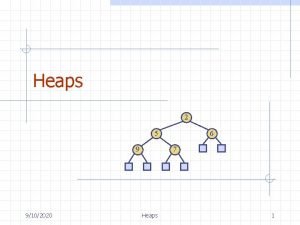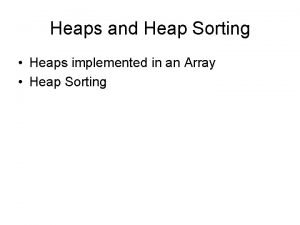Pairing Heaps Pairing Heaps Pairing Heaps Experimental results































- Slides: 31

Pairing Heaps

Pairing Heaps

Pairing Heaps • Experimental results suggest that pairing heaps are actually faster than Fibonacci heaps. § Simpler to implement. § Smaller runtime overheads. § Less space per node.

Definition • A min (max) pairing heap is a min (max) tree in which operations are done in a specified manner. 8 4 2 1 1 6 5 3 3 3 4 2 1 5

Node Structure • Child § Pointer to first node of children list. • Left and Right Sibling § Used for doubly linked list (not circular) of siblings. § Left pointer of first node is to parent. § x is first node in list iff x. left. child = x. • Data • Note: No Parent, Degree, or Child. Cut fields.

Meld – Max Pairing Heap • Compare-Link Operation § Compare roots. § Tree with smaller root becomes leftmost subtree. 9 7 + 6 9 6 3 7 = 7 6 6 3 • Actual cost = O(1). 7

Insert • Create 1 -element max tree with new item and meld with existing max pairing heap. 9 9 7 6 6 3 7 + insert(2) = 2 7 6 6 3 7

Insert • Create 1 -element max tree with new item and meld with existing max pairing heap. 14 9 7 6 6 3 9 7 + insert(14) = • Actual cost = O(1). 7 6 6 3 7

Worst-Case Degree • Insert 9, 8, 7, …, 1, in this order. 9 1 … 7 8 • Worst-case degree = n – 1.

Worst-Case Height • Insert 1, 2, 3, …, n, in this order. 5 4 • Worst-case height = n. 3 2 1

Increase. Key(the. Node, the. Amount) • Since nodes do not have parent fields, we cannot easily check whether the key in the. Node becomes larger than that in its parent. • So, detach the. Node from sibling doublylinked list and meld.

Increase. Key(the. Node, the. Amount) 9 the. Node 6 4 5 2 4 1 2 3 6 1 3 3 2 1 If the. Node is not the root, remove subtree rooted at the. Node from its sibling list. 4

Increase. Key(the. Node, the. Amount) 9 18 2 3 2 6 3 4 3 1 5 2 1 6 1 4 Meld subtree with remaining tree.

Increase. Key(the. Node, the. Amount) 18 2 9 2 6 4 3 1 5 2 4 1 6 3 3 1 • Actual cost = O(1).

Delete Max • If empty => fail. • Otherwise, remove tree root and meld subtrees into a single max tree. • How to meld subtrees? § Good way => O(log n) amortized complexity for remove max. § Bad way => O(n) amortized complexity.

Bad Way To Meld Subtrees • current. Tree = first subtree. • for (each of the remaining trees) current. Tree = compare. Link(current. Tree, next. Tree);

Example 9 8 6 4 2 1 3 7 5 • Delete max. 8 6 4 2 1 3 7 5 8 • Meld into one tree. 7 5 3 1 2 4 6

Example • Actual cost of insert is 1. • Actual cost of delete max is degree of root. • n/2 inserts (9, 7, 5, 3, 1, 2, 4, 6, 8) followed by n/2 delete maxs. § Cost of inserts is n/2. § Cost of delete maxs is 1 + 2 + … + n/2 – 1 = Q(n 2). § If amortized cost of an insert is O(1), amortized cost of a delete max must be Q(n).

Good Ways To Meld Subtrees • • Two-pass scheme. Multipass scheme. Both have same asymptotic complexity. Two-pass scheme gives better observed performance.

Two-Pass Scheme • Pass 1. § Examine subtrees from left to right. § Meld pairs of subtrees, reducing the number of subtrees to half the original number. § If # subtrees was odd, meld remaining original subtree with last newly generated subtree. • Pass 2. § Start with rightmost subtree of Pass 1. Call this the working tree. § Meld remaining subtrees, one at a time, from right to left, into the working tree.

Two-Pass Scheme – Example T 1 T 2 S 1 T 3 T 4 S 2 T 5 T 6 S 3 T 7 S 4 T 8

Two-Pass Scheme – Example S 1 S 2 S 3 S 4 R 1 R 2 R 3

Multipass Scheme • Place the subtrees into a FIFO queue. • Repeat until 1 tree remains. § Remove 2 subtrees from the queue. § Meld them. § Put the resulting tree onto the queue.

Multipass Scheme – Example T 1 T 2 T 3 T 4 T 5 T 6 T 7 T 4 T 6 T 7 T 8 T 5 T 7 T 8 S 1 T 6 T 8 S 1 S 2 T 7 T 8 S 1 S 2 S 3

Multipass Scheme--Example T 7 T 8 S 1 S 2 S 3 S 4 R 1 S 3 R 2

Multipass Scheme--Example R 1 R 2 Q 1 • Actual cost = O(n).

Delete Nonroot Element • Remove the. Node from its sibling list. • Meld children of the. Node using either 2 -pass or multipass scheme. • Meld resulting tree with what’s left of original tree.

Delete(the. Node) 9 the. Node 6 4 3 5 2 4 1 2 3 6 1 3 1 Remove the. Node from its doubly-linked sibling list.

Delete(the. Node) 9 2 6 4 3 5 2 1 1 6 4 2 4 3 3 1 Meld children of the. Node.

Delete(the. Node) 9 2 6 4 3 5 2 1 6 1 3 4 2 1 Meld with what’s left of original tree. 3

Delete(the. Node) 9 3 2 2 6 3 4 3 1 5 2 1 6 1 4 • Actual cost = O(n).
 Experimental vs non experimental
Experimental vs non experimental Experimental vs non experimental
Experimental vs non experimental Descriptive vs correlational vs experimental research
Descriptive vs correlational vs experimental research Disadvantages of experimental research
Disadvantages of experimental research Experimental vs nonexperimental
Experimental vs nonexperimental Skew heaps
Skew heaps Tom heaps
Tom heaps Appear as heaps or piles
Appear as heaps or piles Soft heaps of kaplan and zwick uses
Soft heaps of kaplan and zwick uses Heaps of love
Heaps of love Fibonacci
Fibonacci Heaps law example
Heaps law example Lazy binomial queue
Lazy binomial queue Reheap up and reheap down
Reheap up and reheap down Unique pairing personality
Unique pairing personality Pairing based cryptography
Pairing based cryptography Chargaff's rule of base pairing
Chargaff's rule of base pairing Plb fit pairing
Plb fit pairing Bioflix activity dna replication nucleotide pairing
Bioflix activity dna replication nucleotide pairing Tool holding devices
Tool holding devices Which pairing of sacred text and religion is correct
Which pairing of sacred text and religion is correct Pasta sauce pairing
Pasta sauce pairing Pairing heap
Pairing heap Pairing heap visualization
Pairing heap visualization Epidimorchitis
Epidimorchitis Leftist heap visualization
Leftist heap visualization Www.iphytoscience.com
Www.iphytoscience.com Pairing
Pairing Pairing heap
Pairing heap Rye beer food pairing
Rye beer food pairing Pairing
Pairing Beer and food pairing history
Beer and food pairing history








